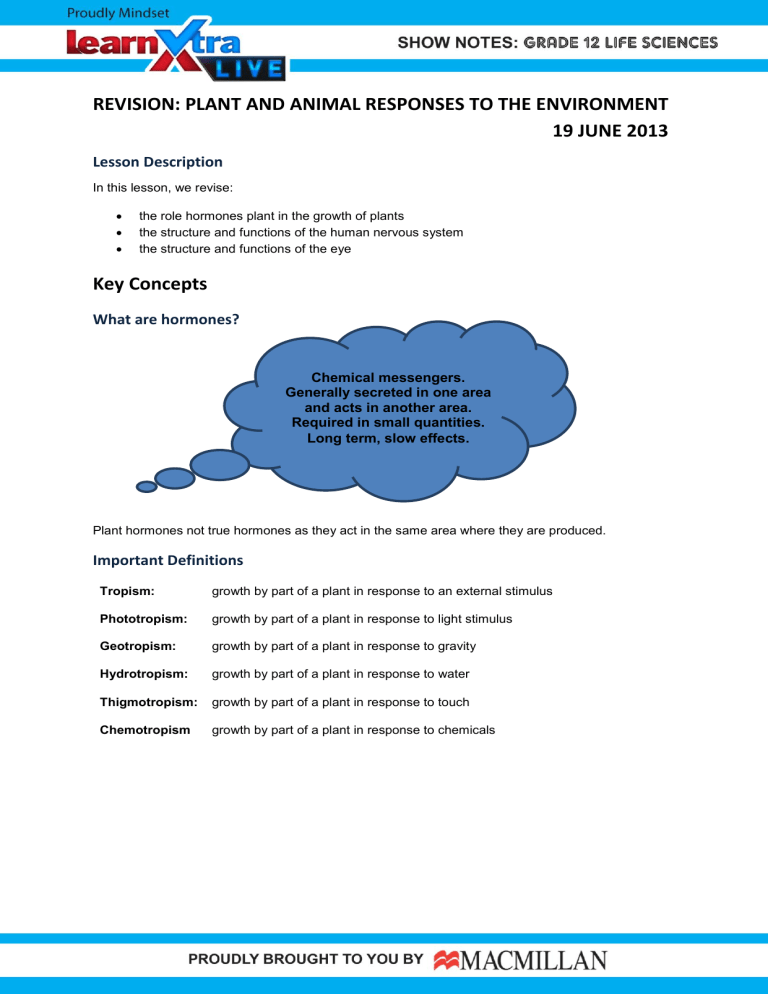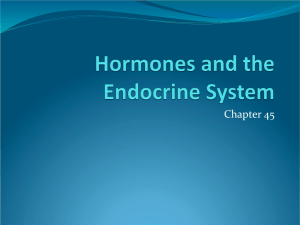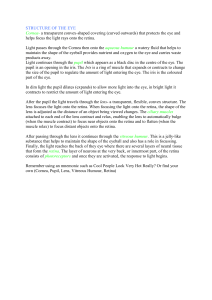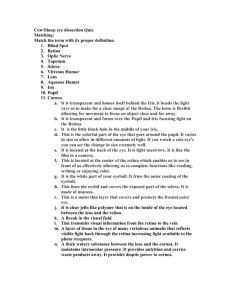
REVISION: PLANT AND ANIMAL RESPONSES TO THE ENVIRONMENT 19 JUNE 2013 Lesson Description In this lesson, we revise: the role hormones plant in the growth of plants the structure and functions of the human nervous system the structure and functions of the eye Key Concepts What are hormones? Chemical messengers. Generally secreted in one area and acts in another area. Required in small quantities. Long term, slow effects. Plant hormones not true hormones as they act in the same area where they are produced. Important Definitions Tropism: growth by part of a plant in response to an external stimulus Phototropism: growth by part of a plant in response to light stimulus Geotropism: growth by part of a plant in response to gravity Hydrotropism: growth by part of a plant in response to water Thigmotropism: growth by part of a plant in response to touch Chemotropism growth by part of a plant in response to chemicals Phototropism Plant Hormones in Agriculture Auxin Selective weed killer (herbicide) Stimulate roots in cuttings May improve the quality of fruit, e.g. tomatoes Many fruit trees, e.g. apple, pears and citrus trees sprayed with auxin to prevent abscission Farmers may use the property of apical dominance to make plants grow thicker… Gibberellins Spraying grapes with gibberellins makes the larger Spraying also makes internodes of the plant bigger to provide more space for individual grapes, which increases air circulation and reduces infection by pathogens. Cytokinins Slow down aging process in some plants – fruit and flower industry. Ethylene Promotes ripening of fruit. Abscisic Acid Seeds sprayed with abscisic acid to prevent germination in winter. The human nervous system Co-ordination For co-ordination to occur effectively, an organism must receive the stimulus, convert the stimulus to an impulse send the impulse to a “control centre” for processing and interpretation, and then respond to the stimulus. Organisation of the Nervous System The Brain Protected by bone (cranium), membranes (meninges) and fluid (cerebro-spinal fluid) Structure of the Brain (Adapted from Life Sciences for All, Grade 12, Macmillan, Fig 2.11, Page 61) Figure 2.12: The sensory, association and motor areas of the human brain – cerebrum (Adapted from Life Sciences for All, Grade 12, Macmillan, Fig 2.12, Page 62) The Spinal Cord The Eye Structure of the Human Eye (Adapted from Life Sciences for All, Macmillan, Fig 2.16, Page 67) Where are the eyes situated? In the front of the head in the eye sockets. What keeps them in position? The various muscles and fat tissue Function of the Different Parts of the Human Eye Sclera Tough, white, protective outer structure. It provides attachment surfaces for eye muscles and protection Cornea Is the transparent, curved front of the eye which helps to converge/refract the light rays which enter the eye Choroid Has a network of blood vessels to supply nutrients to the cells and remove waste products. It is pigmented that makes the retina appear black, thus preventing reflection of light within the eyeball. Retina Is a layer of sensory neurons, photoreceptors (rod and cone cells) which respond to light. Aqueous Humour Helps to maintain the shape of the anterior chamber of the eyeball and helps to distribute nutrients Iris Pigmented muscular structure consisting of an inner ring of circular muscle and an outer layer of radial muscle. Its function is to help control the amount of light entering the eye Iris A hole/space in the middle of the iris where light is allowed to pass. Ciliary Body and Muscles Enable the lens to change shape, during accommodation (focusing on near and distant objects) Suspensory Ligaments Hold lens in position, accommodation Lens The soft biconvex transparent body that lies behind the pupil and which can change shape to focus light rays onto the retina Vitreous Humour Transparent, jelly-like mass located behind the lens. Maintains the shape of the posterior chamber of the eyeball Blind Spot Where the bundle of sensory fibres form the optic nerve; it contains no light-sensitive receptors Fovea/Yellow Spot A part of the retina that is directly opposite the pupil and contains only cone cells. It is responsible for good visual acuity (good resolution) Optic Nerve Transmit impulses from the eye to the cerebral cortex Questions Question 1 a.) Name the five main plant hormones. (5) b.) Tabulate the functions of the three hormones prescribed in the curriculum (13) Question 2 Study the following diagrams and answer the questions. a.) Why is this experiment carried out in darkness? b.) What is the aim of the experiment? c.) Explain the results of the experiment. Question 3 a.) b.) c.) d.) Name the basic unit of the nervous system in humans. Draw labelled diagrams to illustrate the general structure of a neuron Illustrate the differences between neurons based on their structure. Distinguish between the different neurons, based on their functions. Question 4 List the functions of the spinal cord. Question 5 (Adapted from March 2012, NSC, P2, Question 2.2) Study the diagram below showing a reflex arc. A B Reflex arc a.) b.) c.) d.) Identify the neuron labelled A. Name the type of neuron that is connected to structure B. Explain the effect on the body if the neuron mentioned in QUESTION (b.), is damaged. Explain the significance of reflex actions in humans. (1) (1) (3) (2) [7] Question 6 (Adapted from November 2012, NSC, Paper 2, Question 2.1) Study the diagram representing the structure of the human brain below. B A F C E D a.) Identify the parts labelled: i.) C ii.) E b.) Write down the LETTER (A to F) of the part which controls body temperature. c.) Explain how the body would be affected if part A were to be damaged in an accident. (1) (1) (1) (3) [6] Question 7 a.) Distinguish between the terms binocular vision and stereoscopic vision. b.) Study the following diagram and answer the questions that follow: i.) ii.) iii.) iv.) v.) Explain how the eye is protected. Provide labels for parts numbered 1, 3, 5 and 8. Name the process responsible for focussing on near objects so we can see them clearer. Explain the processes taking place in the eye to bring make the above process possible. Now explain what would happen to enable us to see things that are 6m away from us. Question 8 (Adapted from 2005 HG, NSC, Paper 2) Study Diagrams I and II that illustrate parts of the human eye and answer the questions that follow. a.) Name the mechanism responsible for the change in the size of the pupil from I to II. b.) Explain why and how the change in size of the pupil is brought about from I to II. c.) Now explain what happens when the person, mentioned above, goes into a dark room.



